 Image
from http://www.ksci.com/graphics/aberf.gif
Image
from http://www.ksci.com/graphics/aberf.gif| Fibre-reinforced polymer composite bridges in Europe |
Composites UK civil engineering case studies
Bridges: See right-hand column above and Bull Ring Farm Road Overbridge Parapet Wall Coping Calder and Rubha Glas Viaducts Church Road Bridge Development and Testing of New FRP Bridge Deck to UK standards FRP Parapets Mort Lane Parapet Moss Canal Bridge Network Rail/NCC partnership for footbridges River Chor Aqueduct Sedlescombe Bridge Thornaby Footbridge
Civils and Infrastructure: Airshaft Lining Panels East West Rail Core Walkways Goldthorpe Station Replacement Platform Deck Cantilevered Access Staircase - Manchester Piccadilly Station Reading Area Signalling Renewals Ecotrax Composite Railway Sleepers
Architectural London Kings Cross Station Southern Colonnade Entrance Synthetic Stone Slabs
Housing Startlink House Byker Wall Estate Refurbishment
Underpinning technologies
The Composite Construction System [1] was conceived in 1982 as a route to overcome difficulties encountered with the structural use of mass produced composites in construction. The System, commonly referred to as Advanced Composite Construction System (ACCS), consists of a number of interlocking fibre reinforced plastic structural members which can be assembled into a wide range of high performance structures. The two main components are the Plank and the Connector which were designed for manufacture by pultrusion and incorporate keyways to ensure alignment. A Limit State Design methodology and manufacturing specification have been developed for the system and subjected to verification by an extensive test programme [1, 2]. The system is normally ACCS is now marketed as Composolite® [3-5].
Canning et al [4] have described the development of the ASSET (Advanced Structural Systems for Tomorrow’s Infrastructure) pultruded composite profile which was developed in a four-year European Commission funded research project [6].
Yeung and Parker [7] have demonstrated the potential of composite strands made from 5 mm diameter pultruded rods reinforced with unidirectional E-glass, Kevlar 49 aramid or PAN-based carbon fibre. The tension members contained rods in hexagonal close packing and were either 49 mm (diameter of circumscribing circle) with 73 rods (glass) or 45 mm diameter with 61 rods (aramid or carbon) both with an hexagonal plastic jacket. All three options showed high specific stiffness and strength, excellent fatigue lives and acceptable creep properties, with the two high-modulus fibre strands demonstrating distinct performance advantages relative to the conventional steel strand.
The UK Highways Agency (and others) have published a Design Manual for Roads and Bridges with a specific section BD 90/05 Design of FRP Bridges and Highway Structures [8]. The American Association of State Highway and Transportation Officials (AASHTO), in collaboration with the Transportation Structures Council of ACMA, has published Guide Specifications for Design of FRP Pedestrian Bridges to encourage and enable engineers to specify fibre-reinforced plastics (FRP) for this growing market segment [9].
Caron et al [10] have proposed an original structural concept for a footbridge. The bowstring bridge is obtained by elastic buckling of straight glass fibre reinforced polymer (FRP) pipes. The bows are stabilized with cables and carbon fibre zigzag stays. The bridge-deck is supported by crossbars at the intersection nodes of the cables with the stay supports.
Klasztomy et al [11] have developed and elaborated a new CAD methodology for GFRP composite footbridges. The global preliminary and detailed design is based on Eurocodes and EUROCOMP code, and has been positively verified on the CBFB/16.00/2.56 footbridge (study case).
Further reading:
Trade body:
For many years the interests of the composite bridges sector were well represented by the COmposites BRidge Alliance Europe (COBRAE). It is currently anticipated that COBRAE will shortly become the "Fiber Reinforced Composite Structures" Working Group of the International Association for Bridge and Structural Engineering (IABSE).
In September 1987, the UK Department of Transport awarded a contract for the refurbishment of the A19 Tees viaduct by the installation of a 16000 m2 ACCS structural membrane (total weight 250 tonnes) below the road deck. The relatively high capital cost of the membrane was offset by the inclusion of access walkways along the underside of the bridge producing substantial savings in subsequent inspection and maintenance costs, not least in that the need for road closure was eliminated and the enclosed space provided a protected working environment at all times of the year. The road passes over an area with a number of chemical plants and the structure was subject to significant corrosion. If my memory serves me well, the corrosion rate was reduced by 90% after installation of the membrane [By JS: can't find the reference ☹].
Aberfeldy Footbridge (Tayside - Scotland, )
 Image
from http://www.ksci.com/graphics/aberf.gif
Image
from http://www.ksci.com/graphics/aberf.gif
The Aberfeldy Footbridge (main span = 64 metres) joins two parts of the Aberfeldy Golf Club links. It is constructed using the Maunsell Structural Plastics (MSP) Advanced Composite Construction System (ACCS) pultruded interlocking glass fibre-reinforced plastic (GRP) structural units. The ACCS sections are fibreglass reinforced isophthalic polyester resin composites containing UV inhibitors to increase the weathering resistance. The ACCS components are linked together by mechanical interlocks and fixed by adhesive bonding, with no need for drilling or welding. The assembly system is easily completed without special tools or lifting equipment, whilst the low weight enables easy handling and positioning. The bridge has both a GRP deck and GRP towers (designed by MSP) with parallel-laid aramid fibre stay cables (supplied by Linear Composites Limited).
Andel (The Netherlands, 1995)
Bonds Mill Lift Bridge (Gloucestershire, 1995)
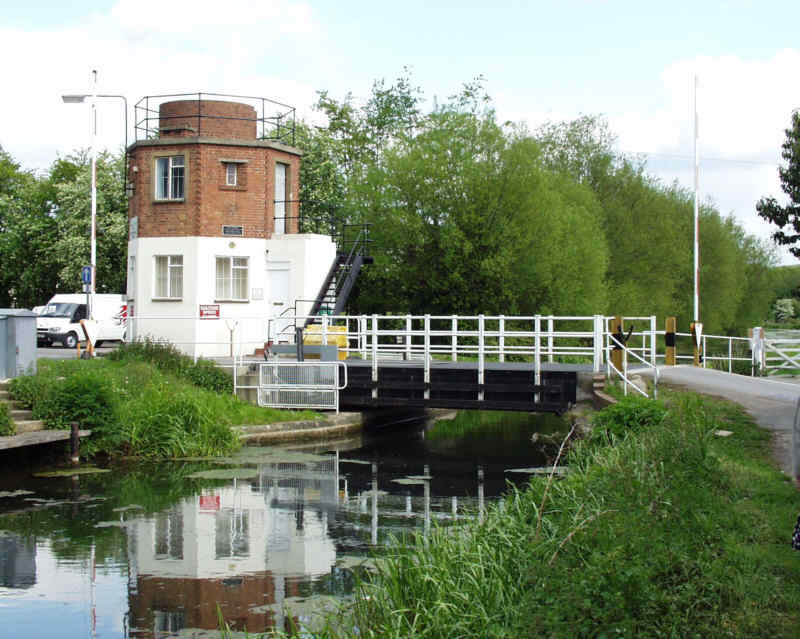
 Images from http://www.stroudwater.co.uk/cpsn/bonds%20mill%20bridge%203.jpg (left), and http://www.ksci.com/graphics/bond.gif (right)
Images from http://www.stroudwater.co.uk/cpsn/bonds%20mill%20bridge%203.jpg (left), and http://www.ksci.com/graphics/bond.gif (right)
The Bonds Mill Lift Bridge crosses the Stroudwater Navigation canal close to Stonehouse and is 8.230 m (27 foot) long by 4.572 m (15 foot) wide. The structure, constructed using the ACCS pultrusion system (see above), weighs 4.5 tons and yet can support loaded trucks up to 44 tons weight to permit access to the adjacent industrial estate for articulated trucks. It is operated hydraulically to allow water traffic to pass underneath. The lightweight of composite materials permitted the use of a smaller lift mechanism than would otherwise be required.
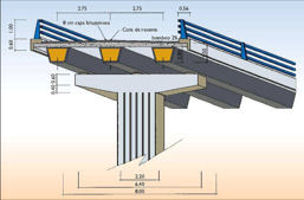
Autovia del Cantabrico, the first carbon-fibre composite bridge in Spain, was constructed by Acciona Infraestructuras of Madrid. The composite elements are three parallel spans (two each at 10 m outboard and 13 m inboard) of 0.8 m deep hollow trapezoidal section. The low weight composite structure (100 kg/m supporting 2500 kg/m of concrete road deck) was easy and quick to assemble. The composite structure was installed using a 50 tonne crane (the equivalent structure in concrete would require a 400 tonne crane) and completed in 10 hours.
Cuenca Parque de los Moralejos (Spain)
Claimed to be the world's longest stress ribbon bridge using pre-tensioned CFRP cables as the main load-bearing members, the project was accepted in 2009, built in 15 months and completed in March 2011. Eighty (80) CFRP cables (16 rows of 5 cables of 43.4 m length and 42 mm diameter) pretensioned to 70 tonnes run the entire length of the bridge.
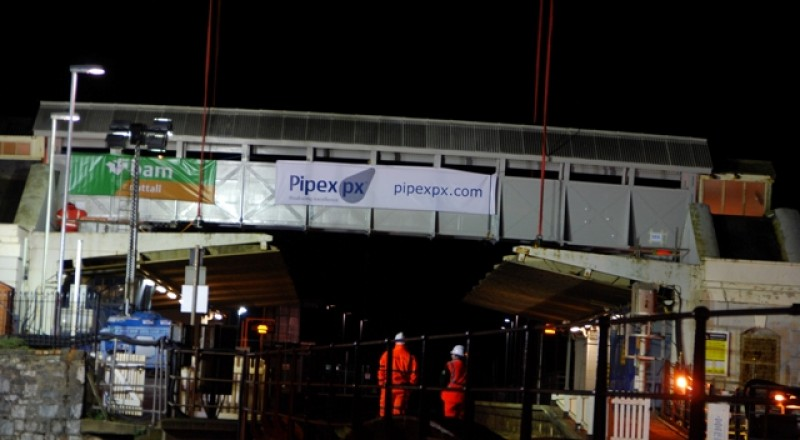
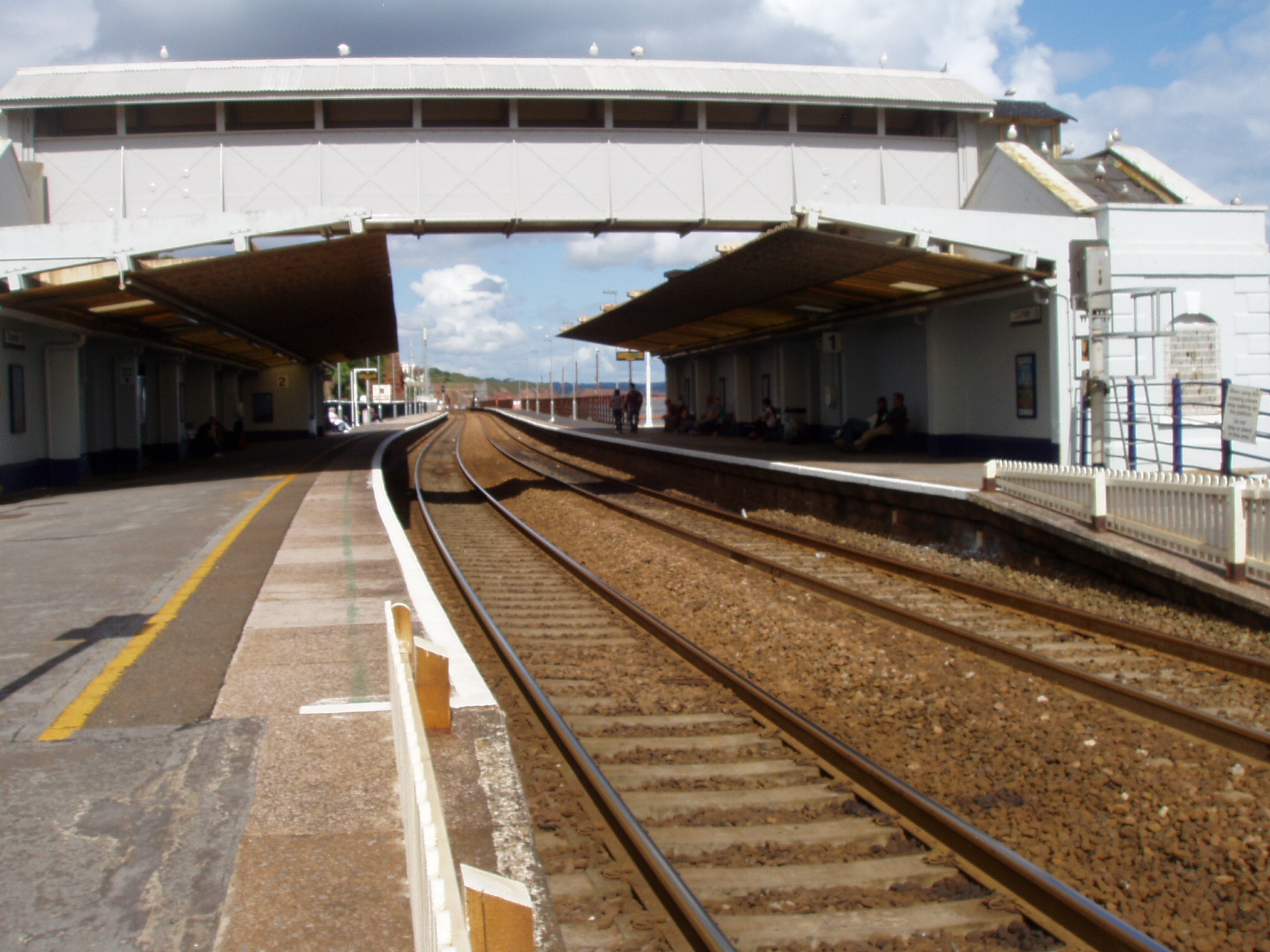
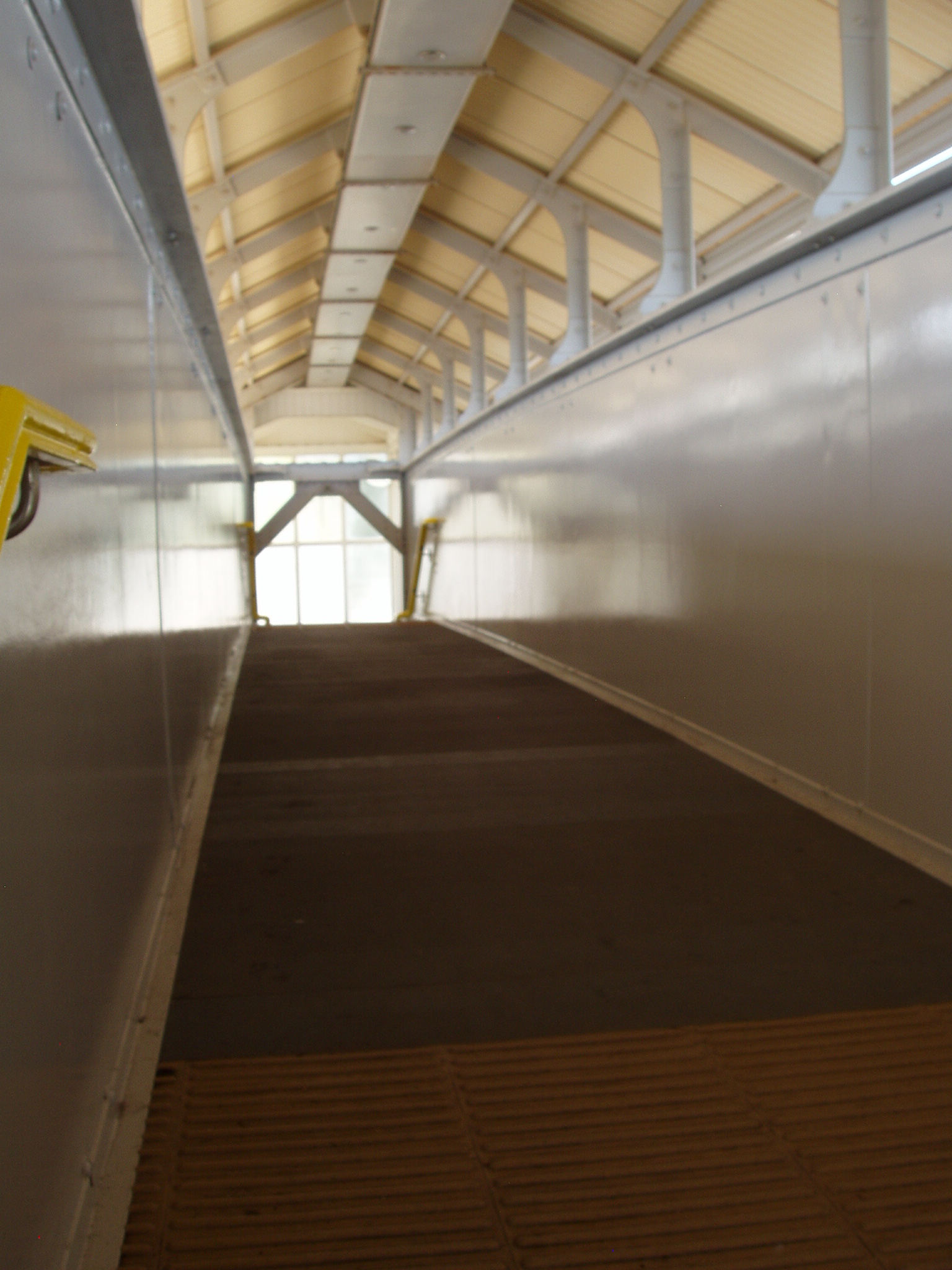
Pipex px has manufactured a 18 m 5 tonne fibre reinforced polymer (FRP) footbridge, which successfully replicates the look of the original 1930s steel bridge, for installation at the Grade II listed Dawlish railway station in South Devon with completion scheduled for the end of November 2012. It is believed to be the first FRP bridge to be installed within a railway station. Safety concerns had been raised as the existing steel footbridge structure suffered severe corrosion damage, the original timber decking had rotted and the protective paintwork had broken down all due to the location in the harsh marine environment of the seafront site.&bsp; In addition to corrosion of the main girders and roof structure. The new FRP structure should require minimal maintenance once installed and significantly reduce overall expenditure over its design life of 120 years. On completion the footbridge became the first Grade II listed FRP bridge.
Den Dungen draw bridge (The Netherlands)
normally Image from http://www.lightweight-structures.com/images/stories/projects/image-bridge1.jpg, with permission from Liesbeth Tromp (© Lightweight Structures BV).The structural design for this bridge in composites with the same configuration as shown was completed, approved by the authorities and within the expected budget. However, for reasons of political expediency the composite bridge deck was not been built.
Eindhoven University of Technology
Friedberg near Frankfurt (Germany, 2008)
The 27 metre long bridge over the German B3 highway comprises two steel beams with a multi-cellular GRP deck made of ASSET pultruded profiles.
Friesland (The Netherlands, 2002)
Garstang Mount Pleasant M6 bridge (Lancashire, April 2006)
The UK Highways Agency has replaced a defective 40-year-old bridge over the M6 motorway in Lancashire with it's first fibre-reinforced polymer (FRP) bridge. The bridge elements were fabricated onsite roadside, then the assembled structure was lifted into position (with minimum disruption to motorway traffic). The new bridge is half the weight of the old bridge but twice as strong. It will support 40 metric tonnes (the standard required weight capacity for network road bridges). The bridge uses the ASSET (Advanced Structural Systems for Tomorrow's Infrastructure) pultruded triangulated profiles made from glass- and carbon-fibre reinforced polymer.
Halgavor (Cornwall, July 2001)
The 47 metre span Halgavor suspension bridge which spans the A30 road near Bodmin is one of the longest curved composite structures in Europe. The bridge deck (designed to carry pedestrians, cyclists and horses) is constructed of composite materials with bonded structural joints. The 4 metre wide deck is supported from four cranked steel masts at the abutments using suspension cables along the length. The FRP deck was manufactured by Vosper Thornycroft using resin infusion with vinyl ester resin (for its enhanced corrosion resistance and mechanical properties) and an ultraviolet (UV) resistant gel-coat. Polyester pultrusions were also used longitudinally to locate the deck. The principal reasons for choosing the composite solution were low maintenance, ease of installation (the FRP site work took four days with the road - one of the busiest sections of dual carriageway in the country - closed for just 24 hours), and the freedom given to the architects to easily design the required shapes, colours and lines.
Holländerbrücke (Reinbek near Hamburg, 2009)
Kolding (Denmark, 1997)
 Image from http://www.cobrae.org/afbeeldingen/afb6.jpg.
Image from http://www.cobrae.org/afbeeldingen/afb6.jpg.
The first composite bridge in Scandinavia was the Fiberline Bridge in Kolding (Denmark), officially opened on 18 June 1997. The bridge carries pedestrians and cyclists over a busy railway line, so installation work was restricted to Saturday and Sunday nights, and was completed after only 3 such nights. The 13 tonne bridge has a span of 40 metres and a load bearing capacity of 500 kg/m2 yet is less than half the weight of a similar steel construction. As a consequence of the light weight further savings were made in reduced foundation requirements, simpler assembly and lower transport costs. The energy consumption for the raw materials production and assembly was estimated at one-quarter of that for a similar construction in either steel or concrete.
Lleida (Lérida) pedestrian footbridge (Spain, 2004)
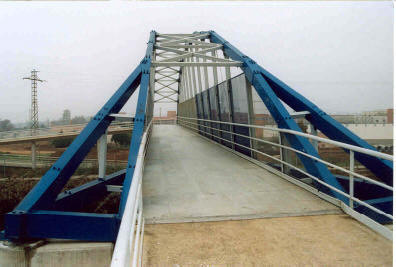 Image from COBRAE News, January/February 2007, (01-07), 8 reproduced with the permission of Jaap Ketel (COBRAE Group General Secretary).
Image from COBRAE News, January/February 2007, (01-07), 8 reproduced with the permission of Jaap Ketel (COBRAE Group General Secretary).
Near the Spanish city of Lleida, crossing the Madrid-Barcelona high-speed rail link, there is an advanced fibreglass footbridge (38 m span by 3 m wide) for pedestrians. The bridge was designed by the Spanish engineering consultants Pedelta and built using structural components supplied by Fiberline Composites A/S (Kolding, Denmark). Key issues in the choice of the GRP solution were that the material is an electrical insulator which eliminates magnetic interference with the electrified railway and that the bridge could be assembled lineside and manoeuvred into position by crane. Railway possession time for complete bridge erection was just three hours.
 Image from COBRAE News, November/December 2010 reproduced with the permission of Jaap Ketel (COBRAE Group General Secretary).
Image from COBRAE News, November/December 2010 reproduced with the permission of Jaap Ketel (COBRAE Group General Secretary).
A second GRP bridge was inaugurated in Lleida - Spain in 2010/11 to connect Lleida university with the old part of the city. Fiberline supplied translucent composite planks for the bridge deck and material for the illuminated benches situated on the bridge.
Lunetten bicycle/pedestrian bridge
 Image from http://www.netcomposites.com/images/210510Baltek200.jpg
Image from http://www.netcomposites.com/images/210510Baltek200.jpg
The Utrecht suburb Lunetten received a new composite bicycle/pedestrian bridge on Wednesday 28 April 2010 to replace an old wooden bridge. The new glass reinforced plastic bridge, designed and built by Lightweight Structures of Delft (NL) has a span of 12 m, a width of 5 m, a weighs 7.5 tonnes (the equivalent reinforced concrete structure would be ten times heavier) and is rated at 45 tonnes. It is claimed to have used less energy at the production stage, to be more durable than the wooden alternative and is anticipated to have a life span of more than eighty years.
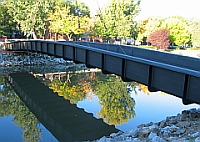 Image from http://www.netcomposites.com/newspic.asp?6634#
Image from http://www.netcomposites.com/newspic.asp?6634#
Acciona Infrastructures worked with Huntsman to design and construct a monolithic single-piece carbon fibre composite pedestrian bridge over the Manzaneres River in Madrid. The 44 m long beam was produced using an injection infusion process with wet lay-up to fill and reinforce the epoxy-bonded prefabricated ribs of the bridge. The space limitations in the city centre site required minimal disruption so the constructors were allowed four hours to mount the bridge onsite but took less than 2 hours using a 75 tonne crane (a steel and concrete bridge typically takes at least 6 hours to install using a 300 tonne crane). It is anticipated that the composite solution will dramatically increase durability and reduce through-life costs and disruption through reduced maintenance requirements. Acciona is currently constructing a 200m long single beam bridge in Cuenca (Spain). Acciona and Huntsman won the Civil Engineering category of the JEC Innovation Awards 2011.
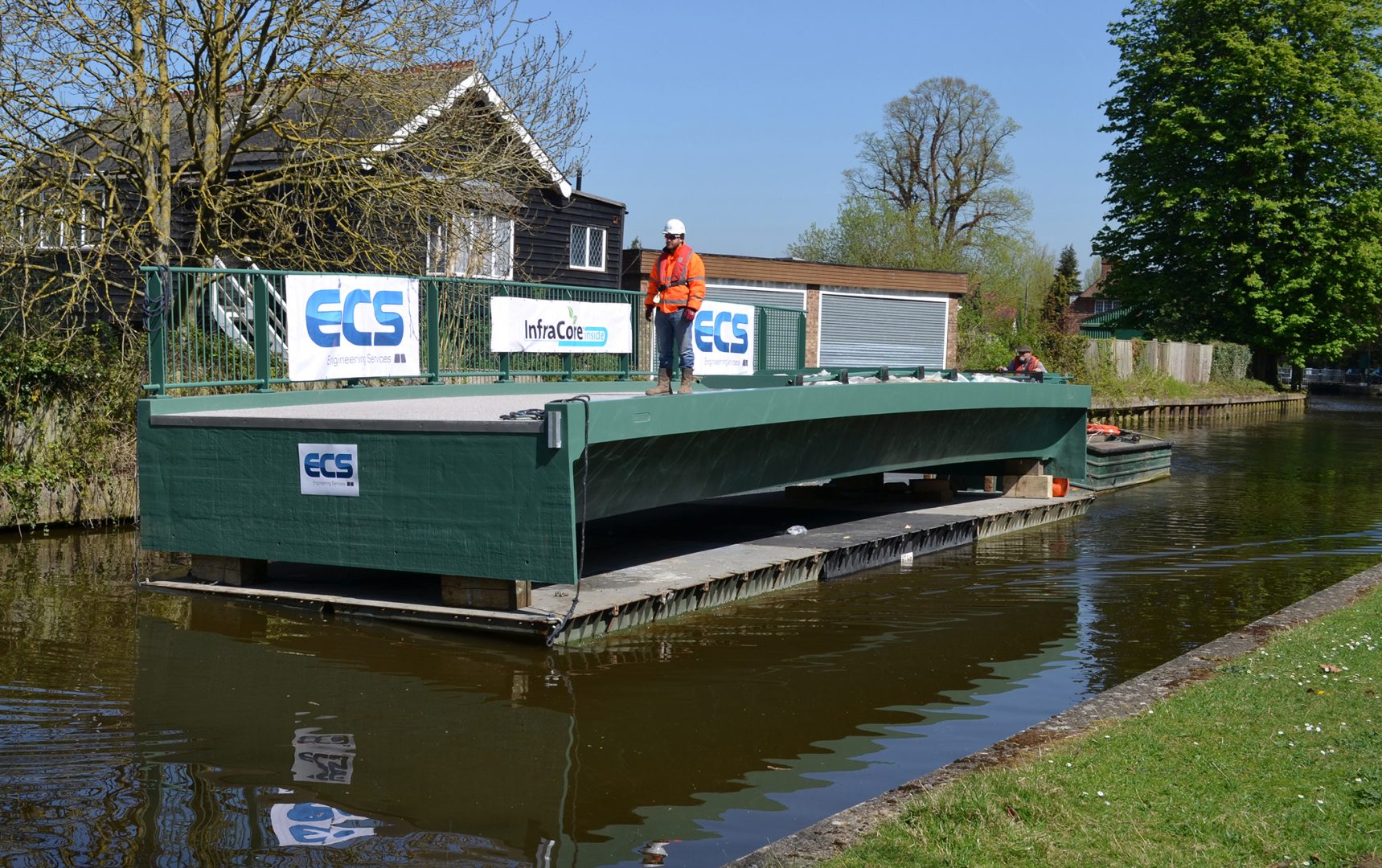 Case Study
Case Study
 Image from
http://www.apatech.ru/yauza_arc_eng.html
Image from
http://www.apatech.ru/yauza_arc_eng.html
On 18 June 2008, the first vacuum-infused footbridge in Russia was installed. The structure was designed by Lightweight Structures BV in the Netherlands and installed by Applied Advanced Technology (ApATeCh) Company Ltd. Ushakov, Ozerov and Dubinsky won the best innovative construction paper award from the American Society of Civil Engineers (ASCE) for their paper on this structure.
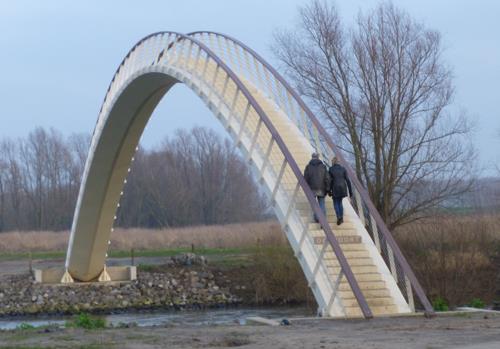
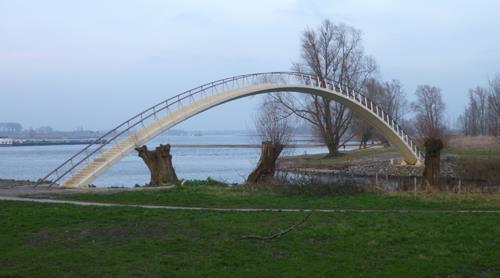 Images from CompositesWorld
Images from CompositesWorld
The Ooypoort glass fiber-reinforced polyester composite pedestrian bridge connecting Nijmegen to Ooijpolder was officially opened on 27 February 2014. The 56 m span bridge was a collaboration between Meerdink Bruggen (main contractor), Olaf Gipser (architect) and Delft Infra Composites (structural engineering and production) with structural design and finite element analysis by Lightweight Structures BV.
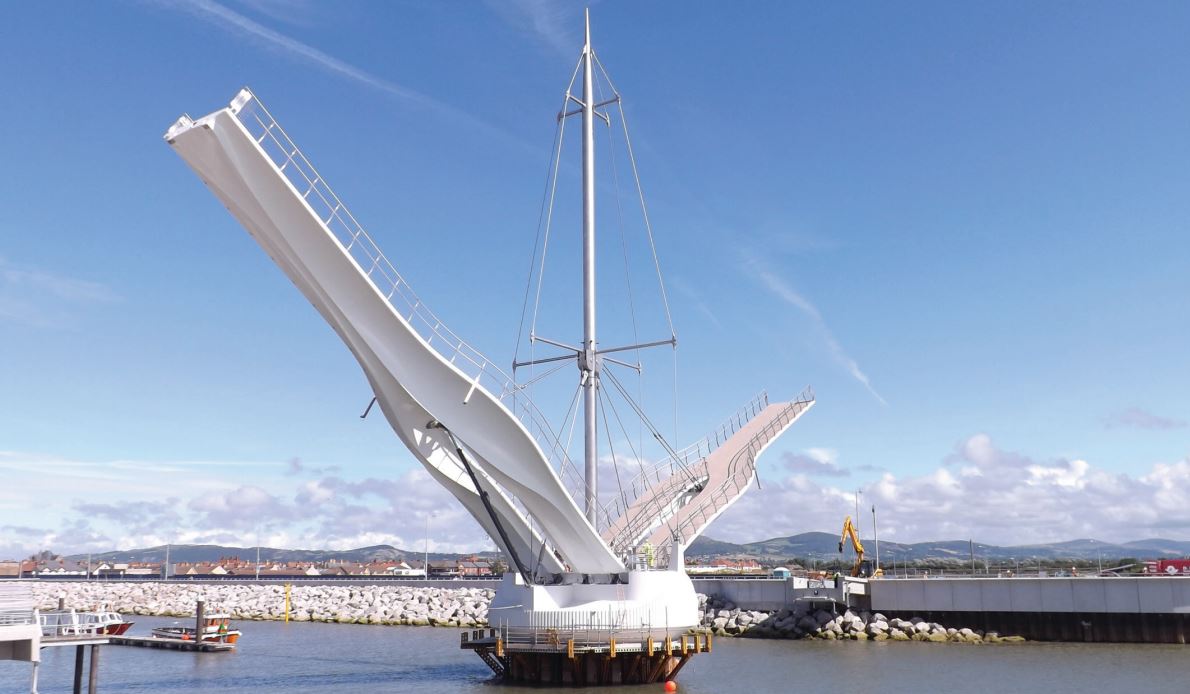 Image from www.gurit.com/-/media/Gurit/Datasheets/Rhyl-Harbour-bridgeguritproject.
Image from www.gurit.com/-/media/Gurit/Datasheets/Rhyl-Harbour-bridgeguritproject.
The “Pont y Ddraig” lifting bridge spans the River Clwyd over Rhyl Harbour in North Wales to offer an additional traffic-free route for pedestrians and cyclists between the counties of Denbighshire and Conwy. AM Structures built the decks using Gurit® Corecell™ M cores, a mixture of glass and carbon reinforcements and Ampreg 21 resin, all supplied by Gurit.
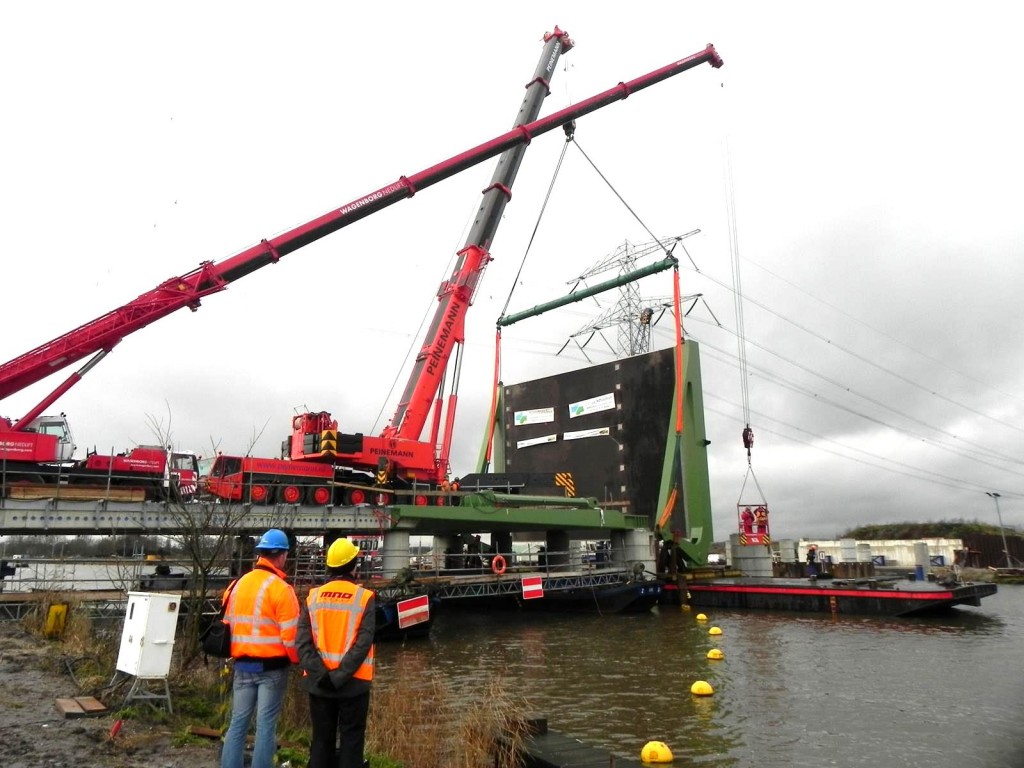 Image from Rijkswaterstaat Ministerie van Infrastructuur en Milieu
Image from Rijkswaterstaat Ministerie van Infrastructuur en Milieu
The Spiering lift bridge crosses the River Vecht near Muiden (NL). The moving section, which is 12 m long by 16 m wide and weighs 80 tonnes, consists of a steel frame with the largest movable plastic bridge deck (a 16 tonne section manufactured in a single vacuum infusion) in the Netherlands. Installed in January 2015, the bridge shoud be completed and fully open by May 2015 ready. Video (YouTube).
St Austell railway bridge (Cornwall, 2007)
The first self-supporting fibre-reinforced plastic bridge installed by Network Rail was lifted into place over the main Penzance-Paddington railway line at St Austell (Cornwall) during the weekend of 20/21 October 2007. The bridge was designed by Parsons Brinkerhoff, manufactured by Pipex (Plymouth) and installed by Edmund Nuttall in three sections: 2 x 2 tonne 6 metre side spans and a central 5 tonne 14 metre span. This is one of a number of FRP pilot structures intended to establish the material as an option for footbridges, platforms, stairs and walkways.
West Mill Bridge (Oxfordshire, 2002)
 Image from
http://ec.europa.eu/research/science-society/science-communication/images/assetbridge.jpg
with permission from Sam Luke (© Mouchel plc).
Image from
http://ec.europa.eu/research/science-society/science-communication/images/assetbridge.jpg
with permission from Sam Luke (© Mouchel plc).
West Mill bridge over the River Cole (near Shrivenham in Oxfordshire) officially opened on 29 October 2002 and was the first public highway bridge in Western Europe constructed using advanced composites. It was developed and built by a consortium of seven European companies within the Advanced Structural Systems for Tomorrow's Infrastructure (ASSET) project. The bridge consists of 4 fibre-reinforced box beams spanning 10 metres bonded to 34 transverse glass fibre-reinforced polymer ASSET profiles. Peter Brown (the County Council's Head of Bridges) stated "We are very pleased to have been part of ASSET. The significant developments made over the last 4 years in ASSET have convinced us of the major potential this technology will have for large asset owners like ourselves in terms of speed of installation, reduced whole life costs, and long term durability. The strength and versatility of the system developed in ASSET gave us the confidence to replace West Mill Bridge with the products developed within the project. We have pioneered the use of new technologies in the County for many years and seen tangible benefits, and we will continue to look for opportunities in the future".
West Mill bridge incorporated an Optical Fibre Bragg Grating (OFBG) sensor-based structural monitoring system using a fluorescent fibre as the optical source with a tuneable, fibre-coupled, Fabry-Perot filter, actuated by piezoelectric transducers and operated over the bandwidth of the source at up to 250 scans/second. Light from the source was filtered and reflected back from the Bragg gratings, through optical couplers, to eight photodiode detectors. These detected the resulting time-domain spectra of the sensors in each of the serially connected sensor arrays [Bogue].
Winterthur (Switzerland, 1996)
The first carbon-fibre tendon cable-stayed vehicle bridge in the world was the Storchenbrücke (Stork Bridge) at Winterthur in Switzerland with twin spans of 63m (207 ft) and 61m (200 ft). Two of the 24 stays are carbon composite tendons put in place to establish their viability and long-term behaviour in this application: the other 22 stays are steel. The bridge-deck spans both a river and a railway station.